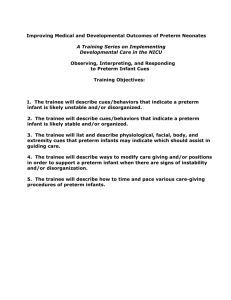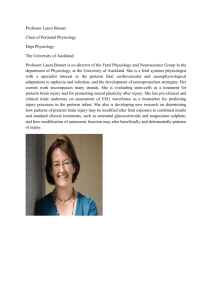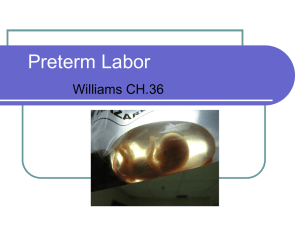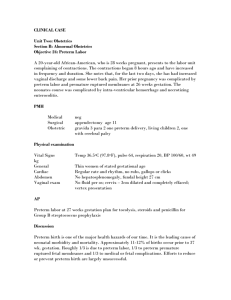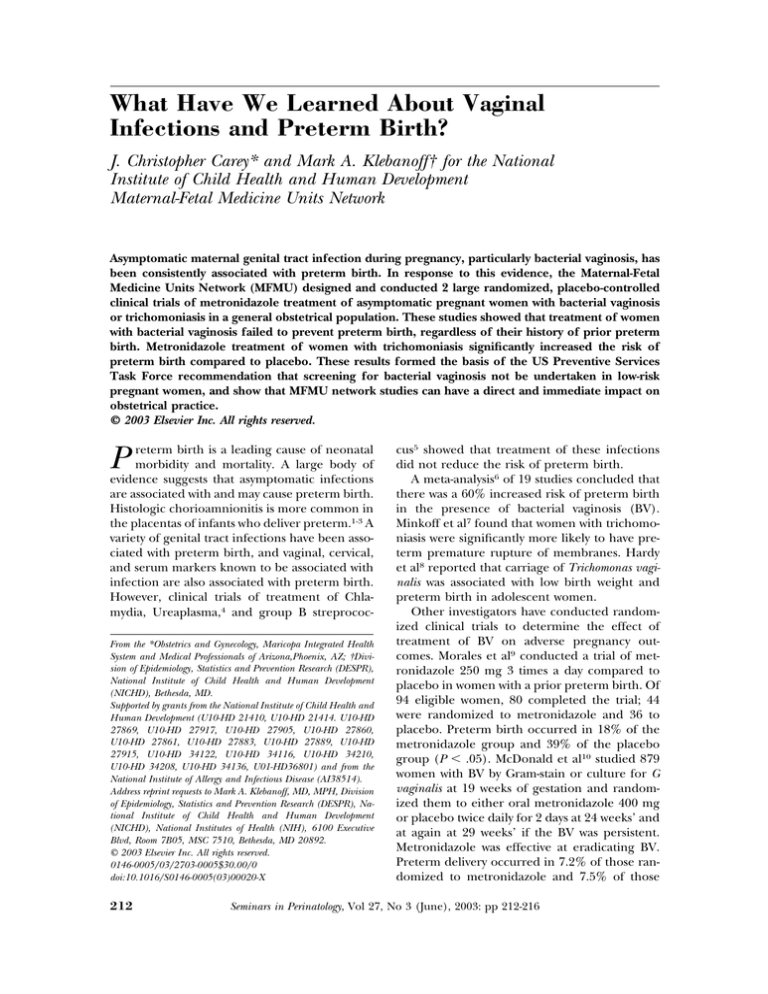
What Have We Learned About Vaginal
Infections and Preterm Birth?
J. Christopher Carey* and Mark A. Klebanoff† for the National
Institute of Child Health and Human Development
Maternal-Fetal Medicine Units Network
Asymptomatic maternal genital tract infection during pregnancy, particularly bacterial vaginosis, has
been consistently associated with preterm birth. In response to this evidence, the Maternal-Fetal
Medicine Units Network (MFMU) designed and conducted 2 large randomized, placebo-controlled
clinical trials of metronidazole treatment of asymptomatic pregnant women with bacterial vaginosis
or trichomoniasis in a general obstetrical population. These studies showed that treatment of women
with bacterial vaginosis failed to prevent preterm birth, regardless of their history of prior preterm
birth. Metronidazole treatment of women with trichomoniasis significantly increased the risk of
preterm birth compared to placebo. These results formed the basis of the US Preventive Services
Task Force recommendation that screening for bacterial vaginosis not be undertaken in low-risk
pregnant women, and show that MFMU network studies can have a direct and immediate impact on
obstetrical practice.
© 2003 Elsevier Inc. All rights reserved.
reterm birth is a leading cause of neonatal
morbidity and mortality. A large body of
evidence suggests that asymptomatic infections
are associated with and may cause preterm birth.
Histologic chorioamnionitis is more common in
the placentas of infants who deliver preterm.1-3 A
variety of genital tract infections have been associated with preterm birth, and vaginal, cervical,
and serum markers known to be associated with
infection are also associated with preterm birth.
However, clinical trials of treatment of Chlamydia, Ureaplasma,4 and group B streprococ-
P
From the *Obstetrics and Gynecology, Maricopa Integrated Health
System and Medical Professionals of Arizona,Phoenix, AZ; †Division of Epidemiology, Statistics and Prevention Research (DESPR),
National Institute of Child Health and Human Development
(NICHD), Bethesda, MD.
Supported by grants from the National Institute of Child Health and
Human Development (U10-HD 21410, U10-HD 21414. U10-HD
27869, U10-HD 27917, U10-HD 27905, U10-HD 27860,
U10-HD 27861, U10-HD 27883, U10-HD 27889, U10-HD
27915, U10-HD 34122, U10-HD 34116, U10-HD 34210,
U10-HD 34208, U10-HD 34136, U01-HD36801) and from the
National Institute of Allergy and Infectious Disease (AI38514).
Address reprint requests to Mark A. Klebanoff, MD, MPH, Division
of Epidemiology, Statistics and Prevention Research (DESPR), National Institute of Child Health and Human Development
(NICHD), National Institutes of Health (NIH), 6100 Executive
Blvd, Room 7B05, MSC 7510, Bethesda, MD 20892.
© 2003 Elsevier Inc. All rights reserved.
0146-0005/03/2703-0005$30.00/0
doi:10.1016/S0146-0005(03)00020-X
212
cus5 showed that treatment of these infections
did not reduce the risk of preterm birth.
A meta-analysis6 of 19 studies concluded that
there was a 60% increased risk of preterm birth
in the presence of bacterial vaginosis (BV).
Minkoff et al7 found that women with trichomoniasis were significantly more likely to have preterm premature rupture of membranes. Hardy
et al8 reported that carriage of Trichomonas vaginalis was associated with low birth weight and
preterm birth in adolescent women.
Other investigators have conducted randomized clinical trials to determine the effect of
treatment of BV on adverse pregnancy outcomes. Morales et al9 conducted a trial of metronidazole 250 mg 3 times a day compared to
placebo in women with a prior preterm birth. Of
94 eligible women, 80 completed the trial; 44
were randomized to metronidazole and 36 to
placebo. Preterm birth occurred in 18% of the
metronidazole group and 39% of the placebo
group (P ⬍ .05). McDonald et al10 studied 879
women with BV by Gram-stain or culture for G
vaginalis at 19 weeks of gestation and randomized them to either oral metronidazole 400 mg
or placebo twice daily for 2 days at 24 weeks’ and
at again at 29 weeks’ if the BV was persistent.
Metronidazole was effective at eradicating BV.
Preterm delivery occurred in 7.2% of those randomized to metronidazole and 7.5% of those
Seminars in Perinatology, Vol 27, No 3 (June), 2003: pp 212-216
Vaginal Infections and Preterm Birth
randomized to placebo. Subgroup analysis of
those who had BV diagnosed by Gram-stain also
showed no effect of treatment on preterm birth
(4.5% v 6.3%). However, in women with a prior
preterm birth, 2 of 22 (9.1%) randomized to
metronidazole delivered preterm compared to
10 of 24 (41.7%) randomized to placebo.
Hauth et al11 studied 624 women at risk for
preterm delivery because of a prior preterm
birth or low prepregnancy weight. They randomized 433 to metronidazole and erythromycin
treatment and 191 to placebo. There was no
significant effect of treatment in women who did
not have bacterial vaginosis. However, women
with BV had significantly decreased rates of preterm birth (31% v 49%). Women were not randomized on the basis of the presence of BV, but
this study showed that high-risk women with BV
may benefit from the combination of erythromycin and metronidazole. However, in this study,
the high-risk women without BV who were
treated with metronidazole and erythromycin
had a significantly increased rate of preterm
delivery at ⬍34 weeks’ when compared women
who were not treated (13.4% v 4.8%, P ⬍ .02).
Six trials have evaluated the effect of intravaginal clindamycin cream on preterm birth in
women with BV.12-17 All but one showed an increased risk of preterm birth in the treated
group.
From the studies reported above, it can be
concluded that there is a strong association between preterm birth and specific infections such
as Chlamydia, BV, and trichomoniasis. However,
antibiotic treatment trials have not consistently
shown a reduction in the risk of preterm birth
and have in some cases shown an increase in the
risk of preterm birth. The Maternal-Fetal Medicine Units Network (MFMU) has performed several studies designed to test the hypothesis that
infections are associated with preterm birth and
that treatment of asymptomatic infections will
prevent preterm birth. This article reviews those
studies.
The Preterm Prediction Study
The Preterm Prediction Study was designed to
determine clinical and laboratory findings that
could be used to predict women at increased risk
for a preterm birth. Meis et al18 reported on the
association of preterm birth and BV diagnosed
213
by Gram-stain using Nugent’s criteria, candidiasis diagnosed by 10% potassium hydroxide preparation, and Trichomonas vaginalis (TV) diagnosed by wet mount of vaginal secretions.
Evaluations were performed at 24 and 28 weeks’
gestation. The rates of detected infection at 24
and 28 weeks’, respectively, were 23.4% and
19.4% for BV, 3.3% and 2.7% for trichomoniasis, and 21.1% and 19.5% for Candida. The occurrence of bacterial vaginosis at 28 weeks’ was
associated with an increased risk of spontaneous
preterm birth with an odds ratio of 1.84 (95%
confidence interval 1.15 to 2.95, P ⬍ .01). Neither TV nor Candida detected by microscopy
had a significant association with preterm birth.
Goldenberg et al19 reported on the association between bacterial vaginosis, fetal fibronectin and preterm birth in 2,899 women followed
in the MFMU Network Preterm Prediction
Study. Bacterial vaginosis was diagnosed by
Gram-stain. Fetal fibronectin was present in
4.0% of cervical and/or vaginal samples at 23 to
24 weeks’ and was nearly twice as common in
women with bacterial vaginosis as in those who
did not have BV. After adjusting for the presence
of BV, race, and parity, they found that women
who were positive for fetal fibronectin were
much more likely to have clinical chorioamnionitis, with an odds ratio of 16.4 and 95% confidence interval of 7.1-37.8, and neonatal sepsis
(6.3; 95% confidence interval ⫽ 2.0-20.0, respectively), than those who were fetal fibronectinnegative. Women with a positive fetal fibronectin test who delivered before 32 weeks’ gestation
all had evidence of histologic chorioamnionitis.
They concluded that the presence of fetal fibronectin at 23 to 24 weeks’, upper genital tract
infection and preterm birth were strongly
linked.
Andrews et al20 reported on the association
between C trachomatis infection at 24 weeks’ as
measured by a urinary ligase chain reaction and
subsequent preterm birth in 190 cases (delivered ⬍ 37 weeks) and 190 controls. Women with
chlamydial infection were more likely to have
bacterial vaginosis (57.1% v 32.9%; P ⫽ .002)
and a short cervical length (ⱕ25 mm; 33.0% v
17.9%; P ⫽ .02) but not a positive fetal fibronectin test result (7.1% v 9.5%; P ⫽ .62). After
adjustment for other risk factors for spontaneous preterm birth, women with C trachomatis
infection at 24 weeks’ gestation were approxi-
214
Carey and Klebanoff
mately 2 times as likely as uninfected women to
have a spontaneous preterm birth at ⬍37 weeks’
gestation (odds ratio, 2.2; 95% confidence interval, 1.03-4.78) and 3 times as likely to have a
spontaneous preterm birth at ⬍35 weeks’ gestation (odds ratio, 3.2; 95% confidence interval,
1.08-9.57).
Goldenberg et al21 reported on the association between granulocyte colony-stimulating factor and spontaneous preterm birth using a
nested case-control study involving 194 women
who had a singleton spontaneous preterm birth
and 194 matched term control subjects. They
reported that women who were delivered of
their infants spontaneously at ⬍28 weeks’ gestation had increased mean granulocyte colonystimulating factor values at 24 weeks’ gestation
(84.7 ⫾ 38.4 v 67.7 ⫾ 28.6 pg/mL; P ⫽.049),
and women who were delivered of their infants
at ⬍32 weeks’ gestation had increased mean
plasma granulocyte colony-stimulating factor values at 28 weeks’ gestation (80.4 ⫾ 24.1 v 55.9 ⫾
16.5 pg/mL; P ⫽ .001). When measured at 24 or
28 weeks’ gestation, granulocyte colony-stimulating factor did not predict spontaneous preterm
birth at 32 to 34 weeks’ gestation or at 35 to 36
weeks’ gestation.
Goepfert et al22 investigated the association
between cervical interleukin 6 concentration at
22 to 24 weeks’ and spontaneous preterm birth.
They compared 125 cases delivered at 35 weeks’
or less with 125 matched controls delivered at 37
weeks’ or greater. The mean ( ⫾SD) interleukin
6 concentration was significantly higher in case
than in control subjects (212 ⫾ 339 v 111 ⫾ 186
pg/mL; P ⫽ .008). Elevated interleukin 6 concentration was not found to be significantly associated with BV, maternal body mass index
⬍19.8 kg/m2, or a short cervix (ⱕ25 mm), but
it was significantly associated with a positive cervicovaginal fetal fibronectin test result (90th percentile, odds ratio, 5.5; 95% confidence interval,
2.6-11.9; 95th percentile, odds ratio, 5.3, 95%
confidence interval, 2.1-12.9). Cervical interleukin 6 levels were highest within 4 weeks of delivery, and the trend continued until term. In a
regression analysis that adjusted for risk factors
significantly associated with spontaneous preterm birth, elevated cervical interleukin- 6 concentration was not independently associated
with spontaneous preterm birth (odds ratio, 1.8;
95% confidence interval, 0.8-4.3).
The BV/TV Study
The BV and TV studies were designed to test the
hypothesis that metronidazole therapy of asymptomatic women who had either bacterial vaginosis or TV would reduce the risk of preterm birth
(delivery ⬍ 37 weeks’). Women who had vaginal
symptoms, significant obstetrical complications
in the current pregnancy, or chronic medical
conditions were excluded. The studies were designed as two nested clinical trials. Women who
had TV were preferentially enrolled in the TV
trial. Women with bacterial vaginosis who did
not have Trichomonas were enrolled in the BV
trial. Over 40,000 women were screened for enrollment in the 2 trials.
BV was diagnosed by Gram-stain and elevated
pH. We randomly assigned 1,953 women with
BV who were 16 to less than 24 weeks pregnant
to receive two 2-gram doses of metronidazole or
placebo23. The diagnostic studies were repeated
and a second treatment was administered to all
women at 24 to less than 30 weeks’ gestation.
Metronidazole therapy was effective at resolving
BV. BV resolved in 657 of 845 women who had
follow-up Gram staining in the metronidazole
group (77.8%) and 321 of 859 women in the
placebo group (37.4%). Data on the time and
characteristics of delivery were available for 953
women in the metronidazole group and 966 in
the placebo group. Preterm delivery occurred in
116 women in the metronidazole group (12.2%)
and 121 women in the placebo group (12.5%)
(relative risk, 1.0; 95% confidence interval, 0.8
to 1.2). Treatment did not prevent preterm deliveries that resulted from spontaneous labor
(5.1% in the metronidazole group v 5.7% in the
placebo group) or spontaneous rupture of the
membranes (4.2% v 3.7%), nor did it prevent
delivery before 32 weeks’ (2.3% v 2.7%). Treatment with metronidazole did not reduce the
occurrence of preterm labor, intraamniotic or
postpartum infections, neonatal sepsis, or admission of the infant to the neonatal intensive care
unit.
Women with TV were enrolled in an identical
trial24. TV was diagnosed by a culture using
Diamond’s media. Cultures were obtained from
31,157 women. Of these, 2,377 were positive
(7.6%). We randomly assigned 617 women with
asymptomatic trichomoniasis who were 16 to 23
weeks pregnant to receive two 2-gram doses of
Vaginal Infections and Preterm Birth
metronidazole (320 women) or placebo (297
women) 48 hours apart and treated women
again with the same 2-dose regimen at 24 to 29
weeks of gestation. Trichomoniasis resolved in
249 of 269 women for whom follow-up cultures
were available in the metronidazole group
(92.6%) and 92 of 260 women with follow-up
cultures in the placebo group (35.4%). Data on
the time and characteristics of delivery were
available for 315 women in the metronidazole
group and 289 women in the placebo group.
Delivery occurred before 37 weeks of gestation
in 60 women in the metronidazole group
(19.0%) and 31 women in the placebo group
(10.7%) (relative risk, 1.8; 95% confidence interval, 1.2 to 2.7; P ⫽ .004). The difference was
attributable primarily to an increase in preterm
delivery resulting from spontaneous preterm labor (10.2% v 3.5%; relative risk, 3.0; 95% confidence interval, 1.5 to 5.9). Preterm delivery was
more common in the metronidazole group
whether BV was also present (26.1% v 14.2%) or
not (14.9% v 8.7%). Metronidazole therapy did
not reduce the occurrence of postpartum endometritis or intra-amniotic infection.
Goldenberg et al25 reported on fetal fibronectin values from 8 to 22 weeks of gestation in
13,360 women who were screened for the
BV/TV study. Vaginal fetal fibronectin values at
each gestational age ranged from unmeasurable
to ⬎1,000 ng/mL, with median values always
being ⬍10 ng/mL. Fetal fibronectin values declined progressively with increasing gestational
age at sampling. BV and black race were associated with higher values, whereas nulliparity was
associated with lower values. High values after 13
weeks’ gestation were associated with a 2- to
3-fold increased risk of subsequent spontaneous
preterm birth overall and a 4-fold increased risk
of very early preterm birth.
215
an underlying condition that causes both genital
infections and preterm birth. Treatment of the
infections might not treat the underlying cause.
If this were true, however, we could not explain
the increased rate of preterm birth seen in
women with trichomoniasis treated with metronidazole, women with bacterial vaginosis treated
with clindamycin cream, or in women without
bacterial vaginosis who were treated with metronidazole and erythromycin. Nor could we explain the fact that some studies have reported
reductions in preterm birth when high-risk
women with BV received treatment. It seems
more plausible that there is a yet unidentified
infection, associated with Chlamydia, BV, and
trichomonas, which causes asymptomatic chorioamnionitis and preterm birth. This infection
might be in the form of chronic, asymptomatic
endometritis26. Whether the various antibiotic
regimens used in these trials effectively treated
this infection is unknown. Further research is
needed to investigate the relationships between
infection and preterm birth. However, based on
our studies, we cannot recommend screening
and treatment of either BV or trichomoniasis in
either low or high-risk women.
The results of the MFMU Network studies
were crucial in the development of the US Preventive Services Task Force’s recent recommendation against routinely screening average-risk
pregnant women for bacterial vaginosis and
their conclusion that evidence is insufficient to
recommend for or against screening high-risk
pregnant women for bacterial vaginosis27. The
rapid incorporation of MFMU Network study
results into practice recommendations is a clear
example of how Network research can have an
immediate, clinically relevant impact.
References
Discusssion
Studies conducted by the MFMU network units
have shown an association between infections
and preterm birth, but the Network’s treatment
trials have not shown a beneficial effect of treatment and in the case of treatment of TV, showed
harm. These results are similar to those seen by
some other investigators. The relationship between infections and preterm birth remains
enigmatic. It is possible that some women have
1. Hillier S, Martius J, Krohn M, et al: A case control study
of chorioamnionic infection and histologic chorioamnionitis in prematurity. N Engl J Med 319:972-978, 1988
2. Hillier S, Krohn M, Kiviat N, et al: Microbiologic causes
and neonatal outcomes associated with chorioamnion
infection. Am J Obstet Gynecol 165:955-961, 1991
3. Martin DH, Eschenbach DA, Nugent RP, et al: Doubleblind placebo-controlled treatment trial of Chlamydia
trachomatis endocervical infections in pregnant women.
Inf Dis Obstet Gynecol 5:10-17, 1997
4. Eschenbach DA, Nugent RP, Rao AV, et al: A randomized placebo-controlled trial of erythromycin for the
216
5.
6.
7.
8.
9.
10.
11.
12.
13.
14.
15.
16.
Carey and Klebanoff
treatment of Ureaplasma urealyticum to prevent premature delivery. Am J Obstet Gynecol 164:734-742, 1991
Klebanoff M, Regan J, Rao A, et al: Outcome of the
Vaginal Infections and Prematurity Study: Results of a
clinical trial of erythromycin among pregnant women
colonized with group B streptococci. Am J Obstet Gynecol 172:1540-1545, 1995
Flynn C, Helwig A, Meurer L: Bacterial vaginosis in
pregnancy and the risk of prematurity: A meta analysis.
J Fam Pract 48:885-892, 1999
Minkoff H, Grunebaum AN, Schwarz RH, et al: Risk
factors for prematurity and premature rupture of membranes: A prospective study of the vaginal flora in pregnancy. Am J Obstet Gynecol 150:965-972, 1984
Hardy P, Hardy J, Nell E, et al: Prevalence of six sexually
transmitted disease agents among pregnant inner city
adolescents and pregnancy outcome. Lancet 2:333-337,
1984
Morales WJ, Schorr S, Albritton J: Effect of metronidazole in patients with preterm birth in preceding pregnancy and bacterial vaginosis: A placebo-controlled,
double-blind study. Am J Obstet Gynecol 171:345-347,
1994
McDonald HM, O’Loughlin JA, Vigneswaran R, et al:
Impact of metronidazole therapy on preterm birth in
women with bacterial vaginosis flora (Gardnerella vaginalis): A randomised, placebo controlled trial. Br J Obstet Gynaecol 104:1391-1397, 1997
Hauth JC, Goldenberg RL, Andrews WW, et al: Reduced
incidence of preterm delivery with metronidazole and
erythromycin in women with bacterial vaginosis. N Engl
J Med 333:1732-1736, 1995
Joesoef MR, Hillier SL, Wiknjosastro G, et al: Intravaginal clindamycin treatment for bacterial vaginosis: Effects
on preterm delivery and low birth weight. Am J Obstet
Gynecol 173:1527-1531, 1995
McGregor J, French J, Jones W, et al: Bacterial vaginosis
is associated with prematurity and vaginal fluid mucinase
and sialidase: Results of a controlled trial of topical
clindamycin cream. Am J Obstet Gynecol 170:1048-1059,
1994
Kekki M, Kurki T, Pelkonen J, et al: Vaginal clindamycin
in preventing preterm birth and peripartal infections in
asymptomatic women with bacterial vaginosis: A randomized, controlled trial. Obstet Gynecol 97:643-648,
2001
Kurkinen-Raty M, Vuopala S, Koskela M, et al: A randomised controlled trial of vaginal clindamycin for early
pregnancy bacterial vaginosis. Br J Obstet Gynaecol 107:
1427-1432, 2000
Rosenstein IJ, Morgan DJ, Lamont RF, et al: Effect of
intravaginal clindamycin cream on pregnancy outcome
17.
18.
19.
20.
21.
22.
23.
24.
25.
26.
27.
and on abnormal vaginal microbial flora of pregnant
women. Infect Dis Obstet Gynecol 8:158-165, 2000
Vermeulen G, Bruinse H: Prophylactic administration of
clindamycin 2% vaginal cream to reduce the incidence
of spontaneous preterm birth in women with an increased recurrence risk: A randomised placebo controlled double blind trial. Br J Obstet Gynaecol 106:652657, 1999
Meis PJ, Goldenberg RL, Mercer B, et al: The preterm
prediction study: Significance of vaginal infections. Am J
Obstet Gynecol 173:1231-1235, 1995
Goldenberg R, Thom E, Moawad A, et al: The preterm
prediction study: fetal fibronectin, bacterial vaginosis,
and peripartum infection: NICHD Maternal Fetal Medicine Units Network. Obstet Gynecol 87:656-660, 1996
Andrews WW, Goldenberg RL, Mercer B, et al: The
Preterm Prediction Study: association of second-trimester genitourinary chlamydia infection with subsequent
spontaneous preterm birth. Am J Obstet Gynecol 183:
662-668, 2000
Goldenberg RL, Andrews WW, Mercer BM, et al: The
preterm prediction study: granulocyte colony-stimulating factor and spontaneous preterm birth: National Institute of Child Health and Human Development Maternal-Fetal Medicine Units Network. Am J Obstet Gynecol
182:625-630, 2000
Goepfert AR, Goldenberg RL, Andrews WW, et al: The
Preterm Prediction Study: association between cervical
interleukin 6 concentration and spontaneous preterm
birth: National Institute of Child Health and Human
Development Maternal-Fetal Medicine Units Network.
Am J Obstet Gynecol 184:483-488, 2001
Carey JC, Klebanoff MA, Hauth JC, et al: Metronidazole
to prevent preterm delivery in pregnant women with
asymptomatic bacterial vaginosis: National Institute of
Child Health and Human Development Network of Maternal-Fetal Medicine Units. N Engl J Med 342:534-540,
2000
Klebanoff MA, Carey JC, Hauth JC, et al: Failure of
metronidazole to prevent preterm delivery among pregnant women with asymptomatic Trichomonas vaginalis
infection. N Engl J Med 345:487-493, 2001
Goldenberg RL, Klebanoff M, Carey JC, et al: Vaginal
fetal fibronectin measurements from 8 to 22 weeks’
gestation and subsequent spontaneous preterm birth.
Am J Obstet Gynecol 183:469-475, 2000
Korn AP, Bolan G, Padian N, et al: Plasma cell endometritis in women with symptomatic bacterial vaginosis.
Obstet Gynecol 85:387-390, 1995
Guise JM, Mahon Sm, Aickin M, et al: Screening for
bacterial vaginosis in pregnancy. Am J Prev Med 20:6272, 2001


